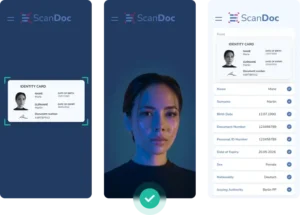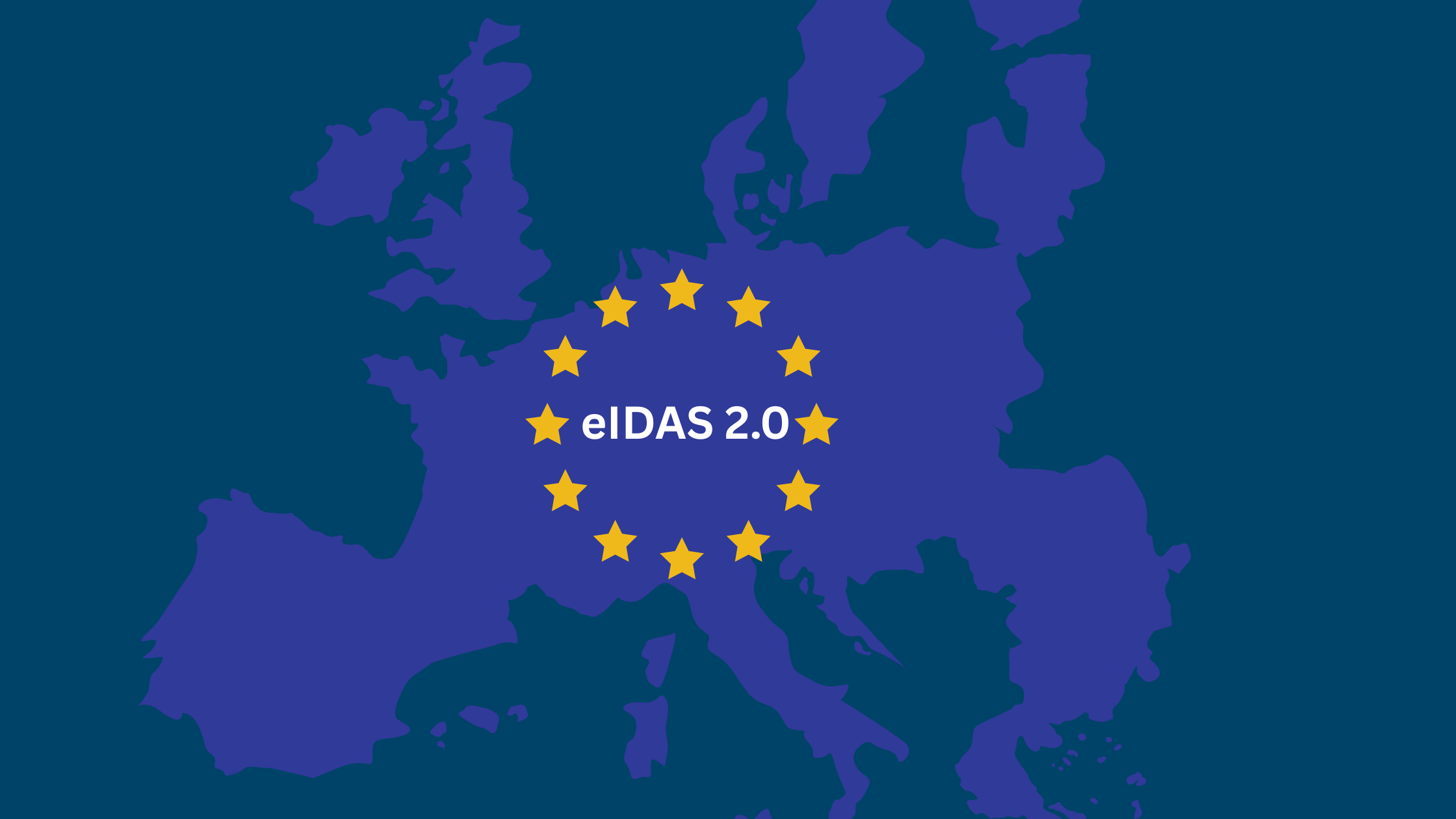Online Identity Document Verification Software

Identity document verification serves as a cornerstone in the digital age, where remote transactions and interactions have become the norm.
This vital process ensures the authenticity of individuals, mitigating the risks of fraud and improving overall security measures.
In this landscape, ScanDoc document scanning emerges as a pivotal tool, offering advanced document scanning capabilities that empower businesses to authenticate identity documents seamlessly.
From passports to driver’s licenses and IDs, ScanDoc enables organizations to verify the legitimacy of crucial documents efficiently and accurately.
By utilizing ScanDoc’s cutting-edge features, businesses can simplify their identity verification processes with high accuracy.
This not only improves operational efficiency but also bolsters security measures, safeguarding against identity theft and fraudulent activities.
Whether utilized for user onboarding procedures, facilitating financial transactions, or meeting stringent compliance requirements, ScanDoc equips organizations with the necessary tools to conduct reliable identity verification swiftly and efficiently.
By integrating ScanDoc into their systems, businesses can fortify their defenses against fraudulent activities, instilling trust and confidence among users and stakeholders alike in an increasingly digitized world.
The Importance of Identity Document Verification Software
In our increasingly digital world, online services such as identity document verification have become integral to our daily lives. From creating a bank account to accessing social media platforms, we rely on digital interfaces for various activities.
However, this convenience has also given rise to identity theft, fraud, and data breaches. Businesses and institutions use cutting-edge identity document verification software to address these security concerns.
This software leverages advanced AI and deep learning methods to perform document scanning (including OCR and MRZ checks), liveness face recognition, and information validation, making it a cornerstone of opening online accounts.
This blog post explores the pivotal role of AI-driven online identity verification software in safeguarding digital interactions and highlights the importance of ScanDoc in the document verification process.

Digital Onboarding Evolution
Historically, the term was predominantly associated with human resources, especially when integrating new employees into an organization.
The onboarding process was defined as the period during which a new employee acquires the essential knowledge and skills to become an integral part of the company.
Traditionally, online customer onboarding took place on-site and in person, such as in a physical bank branch or at a mobile service provider. However, the landscape has drastically changed in recent years.
Digital customer onboarding has become increasingly prevalent, particularly in the wake of the COVID-19 pandemic, necessitating businesses to remotely acquire new customers.
Remote Identity Verification
To remotely verify an individual’s identity, the organization must ascertain if the customer undergoing onboarding is indeed the person they claim to be and whether they are physically present.
The customer’s identity document or passport is scanned and processed in the identity verification process.
Personal data, including first and last name, date of birth, ID number, expiration date as well as photography, are extracted from the document through Optical Character Recognition (OCR), Machine Readable Zone (MRZ), and Near Field Communication (NFC) and cross-referenced and validated with face recognition.
This also involves verifying the authenticity of the document to prevent tampering.
The subsequent step involves biometrically verifying the customer’s selfie against the biometric template created from the photograph extracted from their ID during document processing.
Simultaneously, liveness detection employs various biometric measurements to confirm that the customer’s face is live and genuine rather than a replica.
Two primary approaches to liveness detection exist: active and passive. Active liveness detection requires customers to perform specific actions, such as nodding, moving their eyes, blinking, smiling, moving their heads, devices, or speaking.
In contrast, passive liveness detection, which has gained popularity, operates inconspicuously in the background during selfie capture, making it more challenging for fraudulent attempts to spoof the system.
Best Identity Verification Software: A Comprehensive Approach
Online identity verification software is designed to provide a holistic approach to confirming an individual’s identity. It integrates various technologies and processes to ensure a thorough verification process.
The primary components of online identity verification software include document scanning (including OCR and MRZ checks), liveness face recognition, and information validation.
Document Scanning Using AI and Deep Learning
Document scanning is the initial step in the identity verification process. Users are typically required to provide a scanned image of an official document, such as a passport, driver’s license, or ID card.
The software employs AI and deep learning algorithms to extract information from the document, which is then cross-referenced with the data provided during the registration process.
OCR (Optical Character Recognition): AI-driven OCR technology is pivotal in document scanning. OCR enables the software to recognize and extract text from images, effectively converting printed or handwritten text into machine-readable data.
This capability allows the software to extract critical information like names, addresses, dates of birth, and document numbers from the uploaded document.
MRZ (Machine-Readable Zone) Checks: The MRZ on official documents contains standardized information. AI algorithms are employed to read and validate MRZ data, ensuring its authenticity.
This step is crucial for verifying the legitimacy of the document and detecting any signs of tampering or fraud.
Liveness Face Recognition
Liveness face recognition is another vital component of online identity verification software. This technology ensures that the individual presenting the document is indeed the person they claim to be.
Liveness checks are designed to thwart fraudsters who might attempt to use static images or pre-recorded videos to impersonate someone else.
Deep learning techniques are utilized to perform liveness checks, which may involve various actions, such as blinking, nodding, or smiling, while the software captures and analyzes the user’s facial features in real-time.
The objective is to confirm the user’s presence and prevent attempts at spoofing.
Information Validation
Information validation is the final step in the identity verification process. During this phase, the software cross-references the data extracted from the document with the information provided by the user during registration.
Any inconsistencies or discrepancies may lead to a failed verification, necessitating further investigation or manual verification by a human operator.
Information validation is paramount in preventing identity theft and fraud, as it ensures that the individual’s identity is verified with a high level of accuracy.
The Significance of ScanDoc in Online Identity Verification
While online identity verification software encompasses a range of components, one standout solution for document scanning is ScanDoc. ScanDoc is a technology that specializes in extracting information from official documents and plays a pivotal role in document verification.
Here’s why ScanDoc is crucial in the identity verification process:
High Accuracy and Efficiency: ScanDoc is 99.9% accurate in extracting data from documents. This precision is critical to ensure the verification information is correct and reliable. Furthermore, ScanDoc operates swiftly, simplifying the verification process for users.
Extensive Document Compatibility: ScanDoc supports many official documents, including passports, driver’s licenses, ID cards, and more. This versatility ensures that users can provide the most convenient document, thus enhancing the user-friendliness of the verification process.
Fraud Prevention: ScanDoc is instrumental in preventing fraud. Accurately extracting and validating data from documents substantially reduces the risk of fraudsters using fake or tampered documents for identity verification.
Improved User Experience: A smooth and efficient user experience is essential for online platforms. ScanDoc’s speed and precision contribute to a positive user experience, reducing frustration and bolstering business conversion rates.
The Benefits of AI-Driven Identity Verification Software
Now that we’ve explored the components and processes of online identity verification software, it’s crucial to understand the benefits that this technology offers to both businesses and individuals:
Improves Security: Identity verification software significantly improves security by mitigating the risk of identity theft and fraud. By verifying the identity of users, businesses can ensure that only legitimate individuals access their services.
Regulatory Compliance: Numerous industries, such as finance and healthcare, are subject to strict regulatory requirements for identity verification. Identity verification software helps businesses comply with these regulations, avoiding potential penalties and reputational damage.
Reduced Manual Work: Identity verification software automates the verification process, reducing the need for manual data entry by employees. This not only saves time but also lowers operational costs.
User Convenience: Online users value convenience, and identity verification software provides a seamless and user-friendly experience. It eliminates the need for in-person visits and enables individuals to verify their identity from the comfort of their homes.
Conversion Rates: A simplifyed onboarding process and improved user experience can significantly improve conversion rates. An efficient verification process encourages more users to complete verification and start using the platform.
Trust: Robust identity verification measures on a platform instill trust and confidence in the service. Trust is a significant competitive advantage, attracting users and retaining their loyalty.
Best Practices for an Effective Digital Onboarding Experience
Efficiency and user-friendliness are essential in digital onboarding to make a strong first impression. The identity verification process should be as smooth as possible to prevent user abandonment of time-consuming procedures or malfunctioning apps.
To align with users’ expectations of a fully online process, digital onboarding should be entirely paperless, eliminating the need for physical document submission or branch visits.
Efficiency ensures a quick onboarding process, employing state-of-the-art technology for real-time identity verification. Furthermore, digital onboarding solutions should be accessible anytime, anywhere, and function directly on users’ devices with low bandwidth or offline capabilities.
Security remains paramount, and organizations must only employ digital onboarding solutions to thwart fraud attempts and safeguard user data.
Use Cases of AI-Driven Identity Verification Software
AI-driven identity verification software finds applications in a wide array of industries and use cases:
Financial Services: Banks and financial institutions use AI-driven identity verification software to onboard customers, verify loan applicants, and combat activities like money laundering.
Healtcare: Healthcare providers use AI-driven identity verification to confirm the identity of patients, particularly in telehealth and telemedicine services.
E-Comerce: Online retailers leverage AI-driven identity verification software to prevent fraud in online transactions and ensure that the person making a purchase is the legitimate cardholder.
Travel and Hospitality: Airlines, hotels, and car rental companies use AI-driven identity verification to confirm the identity of travelers and prevent identity fraud.
Online Gaming and Gambling: Online gaming and gambling platforms rely on AI-driven identity verification to enforce age and location restrictions and prevent fraudulent activities.
Conclusion
Online identity verification software, powered by AI and deep learning, is pivotal in securing digital interactions.
It provides a comprehensive solution for online identity verification through document scanning, OCR and MRZ checks, liveness face recognition, and information validation.
ScanDoc, as a specialized solution for document scanning, is indispensable in ensuring that the extracted data from official documents is accurate and reliable. Its accuracy, efficiency, and fraud prevention capabilities make it a key player in document verification.
As the digital landscape evolves, AI-driven identity verification software will remain essential for safeguarding individuals and organizations from identity theft and fraud. Moreover, it helps build trust, improve user experiences, and ultimately drive the growth of online platforms.
In a world where digital identity is increasingly valuable and vulnerable, robust identity verification is more critical than ever.
Click here to find out more about ScanDoc.
FAQ
What is online document identity verification software?
It’s a digital tool that authenticates individuals by verifying their identification documents, such as passports or driver’s licenses, using technologies like OCR and biometric analysis.
How does this software ensure the authenticity of documents?
It employs advanced AI and deep learning methods to perform document data extraction, including OCR and MRZ checks, to validate and inject information into any system or software.
What role does face recognition play in identity verification?
Face recognition, especially when coupled with liveness detection, verifies the live presence of the individual, reducing the risk of identity fraud.
Why is online identity verification necessary in today’s digital world?
With the rise of digital interactions, verifying identities online is crucial to prevent identity theft, fraud, and data breaches.
How does ScanDoc enhance the identity verification process?
ScanDoc offers advanced document scanning capabilities, enabling businesses to authenticate identity documents seamlessly and efficiently.
What types of documents can be verified using this software?
The software can verify over 500 identification documents, including passports, driver’s licenses, and ID cards.
How does OCR technology contribute to identity verification?
OCR (Optical Character Recognition) extracts text from scanned images of documents, allowing for automated data extraction and validation.
What is MRZ, and why is it important?
MRZ (Machine Readable Zone) is a section of identity documents encoded with personal data; scanning and decoding ensures the document’s authenticity.





